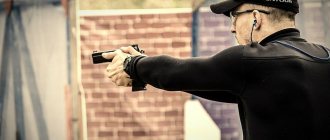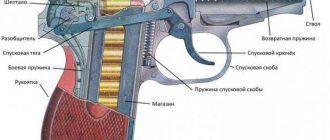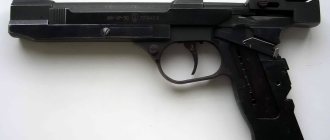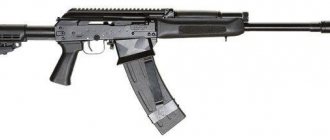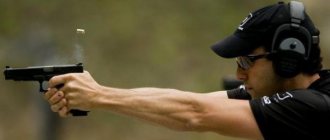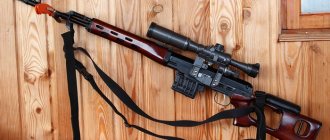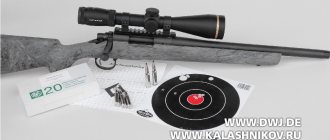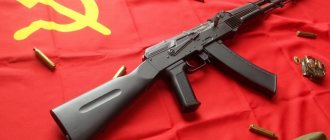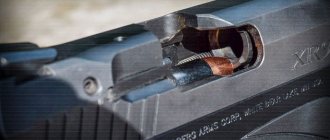- Articles
- Standards for awarding sports titles and categories in practical shooting
Facebook
Russia IPSC Tribune: Dear shooters - athletes, this manual was formed according to draft documents for 2022, kindly provided to us by Alexander Proshin, Executive Director of the FPSR. The documents were transferred to the Ministry of Sports. Links to documents are provided at the end of the article.
If changes and updates are made, we will, as far as possible, make changes to this manual. However, we draw your attention to the fact that our work is for informational purposes only, the manual is not an official document, and the final decision on the issue of accepting documents on the registration of ranks and titles will be made by authorized persons of your regional Federation.
“The liberation of the workers must be the work of the workers themselves” (K. Marx) “The work of helping drowning people is the work of the drowning people themselves!” (I. Ilf, E. Petrov “Twelve Chairs”)
So, dear shooter, a certain incident happened to you: you performed a DISCHARGE during a match. The category number is not important now, the sequence of your further actions is important. So…
First: if practical shooting is just a fun joke for you, do not give in to the provocations of those hinting that it would be nice to design something, continue to make fun jokes. You don't have to read any further.
Second: if you think that a rank is a fixation of a certain stage of your achievements in a sport that is already more than a hobby for you. And by designing the above, you will please not only yourself, but also your instructor/coach, your regional federation and those of your friends with whom you are playing matches, and who also consider their pastime to be a sport, then the text below is for you.
Further point by point.
- To make life easier for those who will be involved in registration in the future, purchase a grade book (if you don’t already have one).
- Fill it out in legible (preferably block) handwriting.
- Take a photo, 3x4 photo
- Paste one of the photos into a grade book.
- Make a photocopy of your passport data and registration page.
- Make sure that on the FPSR website there is a match protocol, which reflects the participation of the required number of athletes in the class and category (attention: the number of athletes is counted according to those registered at the beginning of the match! Those disqualified during the match do not change the number!), as well as a protocol with a list of the panel of judges .
GTO shooting rules
The sporting event “Ready for Labor and Defense” is based on strict competition rules that must be followed by each participant:
- Number of shots – 3 test, 5 test. Is it possible to refuse test shots? Yes, but this must be done in advance so that it doesn’t turn out like this: a person hits the 10 mark 3 times and says: “I shoot without test shots, so these results can be included in the test.”
- Preparation time - 3 minutes, shooting time - 10 minutes (including test shots). It is allowed to start shooting after preparation only after the judge’s signal. If the athlete did not have time to fire 8 shots, then the result that is available at the moment is taken into account.
- Athlete disqualification. Most often it occurs due to the fact that a person began to load the rifle without the judge's command. Such actions are extremely dangerous and therefore are strictly suppressed by the majority of judicial panels.
As for other standards of conduct (shooter’s position, distance to the target, type of target), they depend on the sports discipline (rifle shooting (standing or sitting), pistol, and so on).
Terms
Shooting Sports Federation
The International Sport Shooting Federation (ISSF) is an international sports organization that coordinates the activities of its member national shooting federations. Controls the conduct of international competitions in shooting sports, makes changes to the rules of competitions and their judging.
The European Shooting Confederation (ESC) is the organization that governs shooting sports at the European level and organizes competitions and exercises in each discipline.
The Shooting Union of Russia is an all-Russian sports public organization that unites all Olympic types of shooting from smoothbore and rifled weapons, as well as some non-Olympic shooting disciplines, and represents them on the world sports arena
Abbreviated terms
- ISSF - International Shooting Sports Federation.
- SSR - Rifle Union of Russia.
- VRVS - All-Russian Register of Sports.
- VSK - All-Russian sports calendar.
- EKP is a unified calendar plan for interregional, all-Russian and international physical education and sports events.
- RSC is a regional sports calendar.
- MSMK is the sports title of Master of Sports of Russia of international class.
- MS is a master of sports of Russia.
- Candidate for master of sports.
What rifles are recommended for passing the GTO standards?
Not every air rifle is suitable for passing GTO standards or participating in competitions. We will not dwell on the specific requirements for weapons (since this will take a lot of time), but we will present a list of rifles suitable for the “Ready for Labor and Defense” complex:
- MP-512-24 (combined stock). This rifle is most often found at GTO sports competitions. It has moderate technical characteristics (7.5 J and 150 m/s), good ergonomics, and a simple design.
- MP-61 (with 5-round magazine). A sports modification of the MP-60 (IZH-60), featuring a plastic ergonomic stock, a biathlon cocking mechanism, and a magazine for bullets. The rifle's technical characteristics are tailored for competitions (7.5 J and 150 m/s).
- MP-521С-00 (new version). This modification of the MP-512 has not only an updated design, but also a higher quality build. Additional ergonomics are provided by the rubber butt pad. As for the technical characteristics, they remained unchanged.
- MP-512-44 "Moray eel". One of the newest modifications of the MP-512, characterized by increased bullet speed (up to 180 m/s), as well as improved piston stroke. The weight of the rifle was also reduced from 3 kilograms to 2950 grams.
These are the main rifles that are allowed by the GTO rules. However, as practice shows, athletes with foreign weapons are often allowed to participate in competitions. The most important thing is that it meets all the stated requirements, and that the owner has a passport in his hands that confirms the technical characteristics.
Validity period and by whom assigned
| Rank, rank | Validity | Assigned by |
| International Master of Sports of Russia | For life | Ministry of Sports of the Russian Federation |
| Master of Sports of Russia | For life | Ministry of Sports of the Russian Federation |
| Candidate Master of Sports | 3 years | Executive authorities in the field of physical culture and sports |
| First sports category | 2 years | Executive authorities in the field of physical culture and sports |
| Second, third sports category | 2 years | Local government bodies of the municipal district in the field of physical culture and sports |
After two years, the athlete confirms the rank or receives a higher one, having fulfilled the established standards and requirements.
Recommended reading: Extending the validity of a sports category
What bullets are used
There are also some restrictions among the ammunition used for the “Ready for Labor and Defense” competitions. Here is a small list of ammunition that is allowed for use:
- Gamo Match. Ammunition with a flat tip that leaves even marks on the target when hit. The diameter of the ammunition is 4.5 millimeters, and the weight of each bullet is 0.5 grams. Supplied in a tin in quantities of 250 pieces.
- Alpha "Quintor". Domestic ammunition with a flat tip, similar in characteristics to the previous model, but made of cheaper material. They are usually used during training due to their low cost.
- RWS Match. High quality German 4.5 caliber ammunition with a flat tip. Unlike Gamo Match, each bullet weighs 0.6 grams, which allows you to shoot at targets from a long distance. However, not every rifle will “accept” this cartridge.
And these are just the most common bullets allowed for GTO competitions. You can also use ammunition from other manufacturers. The most important thing is that it does not exceed a caliber of 4.5 millimeters, and also has a flat tip.
All-Russian competition in bullet shooting
- Russian championship.
- Cup of Russia.
- Russian Championship.
- All-Russian sports competition among students.
Interregional competitions
- Championship of the Federal District, Moscow, St. Petersburg.
- Championship of the federal district, two or more federal districts, championship of Moscow, St. Petersburg.
Competitions between a subject of the Federation and a municipal entity
- Championship of a constituent entity of the Russian Federation.
- Championship of a subject of the Russian Federation.
- Spartakiad between the subjects of the Russian Federation.
- Championships of a subject of the Russian Federation.
- Municipal Championship.
- Municipal championship.
Hierarchy of achievements
For receiving a prize in GTO competitions, a gold, silver or bronze badge is awarded. However, in order to achieve such a result, you will have to score a certain number of points in competitions held in a certain hierarchical group:
- 1st stage – schoolchildren from 6 to 8 years old;
- 2nd stage – schoolchildren from 9 to 10 years old;
- 3rd stage – schoolchildren from 11 to 12 years old;
- 4th stage – schoolchildren from 13 to 15 years old;
- 5th stage – schoolchildren from 16 to 17 years old;
- 6th stage – adults from 18 to 29 years old;
- 7th stage – adults from 30 to 39 years old;
- 8th stage – adults from 40 to 49 years old;
- 9th stage – adults from 50 to 59 years old;
- 10th stage – adults from 60 to 69 years old;
- 11th stage – adults over 70 years of age.
Of course, men and women (girls and boys) compete in different categories. As for the standards required to obtain each badge for a member of a particular group, this information will be found in the next section.
Norms and conditions for their implementation in the sport of “bullet shooting”
The assignment of ranks and titles in the sport of “bullet shooting” is regulated by the Unified All-Russian Sports Classification. We recommend that parents print out and study the document: Norms and conditions for their implementation in the sport of “bullet shooting” from the Order of the Ministry of Sports of the Russian Federation dated November 13, 2022 N 988 “On approval of the Unified All-Russian sports classification (sports included in the program of the Olympic Games)”
Norms and conditions for their implementation for conferring the sports title of Master of Sports of Russia of international class and Master of Sports
| N p/p | Sports discipline | Unit | MSMK | MS | ||
| M | AND | M | AND | |||
| 1 | VP-60, air rifle, 10 m, 60 shots standing | Glasses | 592 | 590 | ||
| 2 | VP-60, air rifle, 10 m, 60 shots standing | Points including tenths | 626 | 625,5 | 615 | 613 |
| 3 | VP-40+40, air rifle, 10 m, 40 shots standing, mixed pair | Points including tenths | 417,5 | 417 | 414 | 412,5 |
| 4 | VP/DM-60, air rifle, 10 m, 60 shots (30+30), moving target, slow and fast speeds | Glasses | 578 | 565 | 566 | 550 |
| 5 | VP/DM-40 mix, air rifle, 10 m, 40 shots (20+20), moving target, slow and fast speeds - mix | Glasses | 386 | 372 | 376 | 362 |
| 6 | MV-3×40, small-caliber rifle, 50 m, 120 shots (3×40), three positions | Glasses | 1173 | 1168 | 1149 | 1144 |
| 7 | MV-60, small-caliber rifle, 50 m, 60 shots prone | Points including tenths | 626 | 624 | 619 | 617 |
| 8 | MV/DM-40, small-caliber rifle, 50 m, 40 shots (20+20), moving target, slow and fast speeds | Glasses | 385 | |||
| 9 | MV/DM-40 mix, small-caliber rifle, 50 m, 40 shots (20+20), moving target, slow and fast speeds - mix | Glasses | 390 | 382 | ||
| 10 | MV/DM-60, small-caliber rifle, 50 m, 60 shots (30+30), moving target, slow and fast speeds | Glasses | 585 | 577 | ||
| 11 | KV-3x20, large-caliber rifle, 300 m, 60 shots (3x20), three positions | Glasses | 578 | 565 | ||
| 12 | KVS-3x20, large-caliber rifle, 300 m, 60 shots (3x20), rapid fire, three positions (2x10 -120 seconds kneeling, 90 seconds prone, 120 seconds standing) | Glasses | 570 | 565 | ||
| 13 | KVP-3x20, free large-caliber rifle, 300 m, 60 shots (3x20), three positions | Glasses | 570 | |||
| 14 | KVP-3x40, free large-caliber rifle, 300 m, 120 shots (3x40), three positions | Glasses | 1162 | 1145 | ||
| 15 | KVP-60, large-caliber free rifle, 300 m, 60 shots prone | Glasses | 596 | 590 | ||
| 16 | PP-60, pneumatic pistol, 10 m, 60 shots | Glasses | 585 | 577 | 577 | 567 |
| 17 | PP-40+40, pneumatic pistol, 10 m, 40 shots, mixed pair | Glasses | 387 | 385 | 382 | 378 |
| 18 | MP-60, standard small-caliber pistol, 25 m, 60 shots (30+30) | Glasses | 582 | 580 | 575 | |
| 19 | MP-60SS, standard small-caliber pistol, 25 m, 60 shots (2×30), rapid fire at 5 targets, 8-6-4 seconds | Glasses | 582 | 570 | ||
| 20 | MP-60M, standard small-caliber pistol, 25 m, 60 shots (20+20+20), limited time 150-20-10 seconds | Glasses | 583 | 575 | ||
| 21 | MPP-30, small-caliber random pistol, 50 m, 30 shots | Glasses | 273 | |||
| 22 | MPP-30+30, small-caliber random pistol, 50 m, 60 shots, mixed pair | Glasses | 276 | 273 | ||
| 23 | MPP-40, small-caliber random pistol, 50 m, 40 shots | Glasses | 368 | |||
| 24 | MPP-60, small-caliber random pistol, 50 m, 60 shots | Glasses | 565 | 552 | ||
| 25 | KP-60, large-caliber pistol or revolver, 25 m, 60 shots (30+30) | Glasses | 590 | 585 | ||
1. MSMK is assigned to:
1.1. When fulfilling the norm at sports competitions that have a status not lower than international sports competitions included in the EKP, including at the World Universiade.
1.2. For the place indicated below, in the event that not a single participant in the following sporting competitions has fulfilled a norm equal to the MSMK norm:
1.2.1. For 1-8 place at the Olympic Games.
1.2.2. For 1-6 place at the World Championships.
1.2.3. For 1-4 places at the World Cup or European Championship.
1.2.4. For 1-2 places in international sports competitions included in the ECP, held according to the World Cup regulations.
1.2.5. For 1-2 places at the world championship among juniors and juniors (under 21 years old).
2. MS is awarded for fulfilling a standard at sports competitions that have a status not lower than the status of all-Russian sports competitions included in the EKP, including the World Universiade.
3. The number of participants in the type of program (declared exercise) must be at least 8 athletes.
4. The Russian Championship is held in age groups: juniors, juniors (under 21 years old); boys, girls (under 19 years old); boys, girls (up to 17 years old).
5. The Spartakiad between the constituent entities of the Russian Federation is held in age groups: juniors, juniors (21-25 years), boys, girls (15-17 years). This clause is valid until 01/01/2019.
5. To participate in sports competitions, an athlete must reach the established age in the calendar year of the sports competition.
7. In sports disciplines in which there is a final, points scored in the final are not taken into account.
Download document
Norms and conditions for their implementation for the assignment of sports titles MSMK and MS
Norms and conditions for their implementation for the assignment of sports categories
CMS is performed from the age of 12, I-III sports categories - from 10 years
| N p/p | Sports discipline | Unit | KMS | Sports categories | ||||||
| I | II | III | ||||||||
| M | AND | M | AND | M | AND | M | AND | |||
| 1 | VP-20, air rifle, 10 m, 20 shots from a prone position | Glasses | 165 | 165 | ||||||
| 2 | VP-30, air rifle, 10 m, 30 shots prone | Glasses | 291 | 288 | ||||||
| 3 | VP-40, air rifle, 10 m, 40 shots standing | Glasses | 388 | 386 | 383 | 381 | 376 | 372 | ||
| 4 | VP-60, air rifle, 10 m, 60 shots standing | Glasses | 582 | 580 | 566 | 564 | ||||
| Points including tenths | 605,0 | 603,0 | 588,0 | 584,0 | ||||||
| 5 | VP-40+40, air rifle, 10 m, 40 shots standing, mixed pair | Points including tenths | 410 | 408 | ||||||
| 6 | VP/DM-20, air rifle, 10 m, 20 shots, moving target, slow speed | Glasses | 180 | 175 | 170 | 165 | 160 | 155 | ||
| 7 | VP/DM-60, air rifle, 10 m, 60 shots (30+30), moving target, slow and fast speeds | Glasses | 550 | 535 | 535 | 510 | ||||
| 8 | VP/DM-40 mix, air rifle, 10 m, 40 shots (20+20), moving target, slow and fast speeds - mix | Glasses | 366 | 352 | 350 | 355 | 320 | 310 | 310 | 300 |
| 9 | MV-20, small-caliber rifle, 25 or 50 m, 20 shots from a prone position | Glasses | 170 | 166 | ||||||
| 10 | MV-30, small-caliber rifle, 25 or 50 m, 30 shots prone | Glasses | 285 | 282 | 260 | 257 | ||||
| 11 | MV-3x20, small-caliber rifle, 50 m, 60 shots (3x20), three positions | Glasses | 570 | 565 | 548 | 543 | ||||
| 12 | MV-3×40, small-caliber rifle, 50 m, 120 shots (3×40), three positions | Glasses | 1129 | 1 124 | 1100 | 1085 | ||||
| 13 | MV-60, small-caliber rifle, 50 m, 60 shots prone | Glasses | 590 | 588 | 584 | 582 | 579 | 577 | ||
| Points including tenths | 616,0 | 614,0 | 611,0 | 609,0 | 605,0 | 603,0 | ||||
| 14 | MV/DM-20, small-caliber rifle, 50 m, 20 shots, moving target, slow speed | Glasses | 182 | 172 | 162 | |||||
| 15 | MV/DM-40, small-caliber rifle, 50 m, 40 shots (20+20), moving target, slow and fast speeds | Glasses | 375 | 365 | 353 | 343 | ||||
| 16 | MV/DM-40 mix, small-caliber rifle, 50 m, 40 shots (20+20), moving target, slow and fast speeds - mix | Glasses | 372 | 362 | ||||||
| 17 | MV/DM-60, small-caliber rifle, 50 m, 60 shots (30+30), moving target, slow and fast speeds | Glasses | 565 | 555 | ||||||
| 18 | KV-3x20, large-caliber rifle, 300 m, 60 shots (3x20), three positions | Glasses | 547 | 530 | ||||||
| 19 | KVS-3x20, large-caliber rifle, 300 m, 60 shots (3x20), rapid fire, three positions (2x10 -120 seconds kneeling, 90 seconds prone, 120 seconds standing) | Glasses | 545 | 535 | ||||||
| 20 | KVP-3x20, free large-caliber rifle, 300 m, 60 shots (3x20), three positions | Glasses | 560 | 545 | ||||||
| 21 | KVP-3x40, free large-caliber rifle, 300 m, 120 shots (3x40), three positions | Glasses | 1125 | 1100 | ||||||
| 22 | KVP-60, large-caliber free rifle, 300 m, 60 shots prone | Glasses | 585 | 580 | ||||||
| 23 | PP-20, pneumatic pistol, 10 m, 20 shots standing from a rest (tripod) | Glasses | 173 | 169 | ||||||
| 24 | PP-30, pneumatic pistol, 10 m, 30 shots | Glasses | 262 | 257 | 252 | 247 | ||||
| 25 | PP-40, pneumatic pistol, 10 m, 40 shots | Glasses | 376 | 368 | 363 | 358 | 350 | 343 | ||
| 26 | PP-60, pneumatic pistol, 10 m, 60 shots | Glasses | 565 | 555 | 545 | 537 | ||||
| 27 | PP-40+40, pneumatic pistol, 10 m, 40 shots, mixed pair | Glasses | 376 | 368 | ||||||
| 28 | MP-20, standard small-caliber pistol, 25 m, 20 shots, fixed target | Glasses | 182 | 177 | 177 | 175 | ||||
| 29 | MP-30, standard small-caliber pistol, 25 m, 30 shots, fixed target | Glasses | 279 | 272 | 273 | 266 | ||||
| 30 | MP-30S, standard small-caliber pistol, 25 m, 30 shots, rapid fire, 3 seconds per shot | Glasses | 284 | 281 | 277 | 274 | 270 | 267 | ||
| 31 | MP-60, standard small-caliber pistol, 25 m, 60 shots (30+30) | Glasses | 570 | 564 | 560 | 552 | 550 | 540 | ||
| 32 | MP-30SS, standard small-caliber pistol, 25 m, 30 shots, rapid fire at 5 targets, 8-6-4 seconds | Glasses | 282 | 277 | 272 | |||||
| 33 | MP-60SS, standard small-caliber pistol, 25 m, 60 shots (2×30), rapid fire at 5 targets, 8-6-4 seconds | Glasses | 560 | 550 | 540 | |||||
| 34 | MP-60M, standard small-caliber pistol, 25 m, 60 shots (20+20+20), limited time 150-20-10 seconds | Glasses | 570 | 550 | 540 | |||||
| 35 | MPP-30, small-caliber random pistol, 50 m, 30 shots | Glasses | 262 | 252 | 243 | 235 | ||||
| 36 | MPP-30+30, small-caliber random pistol, 50 m, 60 shots, mixed pair | Glasses | 270 | 262 | 258 | 252 | 250 | 243 | 240 | 235 |
| 37 | MPP-40, small-caliber random pistol, 50 m, 40 shots | Glasses | 360 | 345 | 335 | 320 | ||||
| 38 | MPP-60, small-caliber random pistol, 50 m, 60 shots | Glasses | 540 | 530 | 515 | |||||
| 39 | KP-60, large-caliber pistol or revolver, 25 m, 60 shots (30+30) | Glasses | 577 | 562 | ||||||
1. The CCM is awarded for fulfilling a standard at sports competitions that have a status not lower than the status of official sports competitions of a constituent entity of the Russian Federation.
2. I, II, III sports categories are assigned for fulfilling the norm at official sports competitions of any status.
3. The number of participants in the type of program (declared exercise) must be at least 8 athletes.
4. The Russian Championship is held in age groups: juniors, juniors (under 21 years old); boys, girls (under 19 years old); boys, girls (up to 17 years old).
5. The Spartakiad between the constituent entities of the Russian Federation is held in age groups: juniors, juniors (21-25 years), boys, girls (15-17 years). This clause is valid until 01/01/2019.
6. To participate in sports competitions, an athlete must reach the established age in the calendar year of the sports competition.
7. In sports disciplines in which there is a final, points scored in the final are not taken into account.
GTO standard for air rifle shooting
To receive a gold, silver or bronze badge, you will have to score a certain number of points by participating in shooting competitions. It is worth noting that we are not talking about the number of points awarded by judges for hits on targets during the individual competition:
Men and women
Participants of the GTO, whose age is at least 18 years old, can test themselves in competitions in air rifle shooting from a sitting position (with their elbows resting on the table) or standing (at the athlete’s choice). Here is a list of steps and points required to receive a prize:
- 6, 7, 8 steps (men): gold – 30 points, silver – 25 points, bronze – 18 points;
- 6, 7, 8 steps (women): gold – 25 points, silver – 20 points, bronze – 15 points;
- 9, 10, 11 steps (men): gold – 25 points, silver – 20 points, bronze – 15 points;
- 9, 10, 11 steps (women): gold – 20 points, silver – 15 points, bronze – 10 points.
Points are calculated depending on what place the athlete received in the individual competition, how many hit points he scored (in relation to other participants) and how many penalty points he received for non-compliance with the rules. All this is very complicated and is calculated according to a certain scheme. However, the point remains the same - the more points you get, the higher the likelihood of getting gold.
Pupils
Schoolchildren of levels 1, 2 and 3 can only take part in pneumatic shooting competitions from a sitting position from a distance of 5 meters. Older participants (4th and 5th level) have the choice of shooting standing or sitting (distance 10 meters). In order to receive badges, you will have to score the following number of points:
- 1,2, 3rd stage (girls): gold – 10 points, silver – 15 points, bronze 20 points;
- 1st, 2nd, 3rd stage (boys): gold – 15 points, silver – 20 points, bronze 25 points;
- Stage 4, 5 (girls): gold – 15 points, silver – 20 points, bronze 25 points;
- 4th, 5th stage (boys): gold – 20 points, silver – 25 points, bronze 30 points.
Also, many parents of schoolchildren are concerned about the question of whether their children can take part in competitions without any permits or licenses. We answer: teachers and coaches bear full responsibility for their students, so no documents are required from students.
Sports disciplines
Shooting competitions are held in the following sports disciplines included in the All-Russian Register of Sports:
Air rifle (VP):
- VP-20, air rifle, 10 m, 20 shots from a prone position;
- VP-30, air rifle, 10 m, 30 shots prone;
- VP-40, air rifle, 10 m, 40 shots standing;
- VP-60, air rifle, 10 m, 60 shots standing;
- VP-40+40, air rifle, 10 m, 40 shots standing, mixed pair;
- VP-180, team competition (3 people x 60 shots).
Air rifle, moving target (VP/DM):
- VP/DM-20, air rifle, 10 m, 20 shots, moving target, slow speed;
- VP/DM-40 mix, air rifle, 10 m, 40 shots (20 + 20), moving target, slow and fast speeds - mix;
- VP/DM-60, air rifle, 10 m, 60 shots (30 + 30), moving target, slow and fast speeds;
- VP/DM-120 mix, team competition (3 people x 40 shots);
- VP/DM-180, team competition (3 people x 60 shots).
Small caliber rifle (MB):
- MV-20, small-caliber rifle, 25 or 50 m, 20 shots from a prone position;
- MV-30, small-caliber rifle, 25 or 50 m, 30 shots prone;
- MV-60, small-caliber rifle, 50 m, 60 shots prone;
- MV-3×20, small-caliber rifle, 50 m, 60 shots (3×20), three positions;
- MV-3×40, small-caliber rifle, 50 m, 120 shots (3×40), three positions;
- MV-180 prone, team competition (3 people x 60 shots), prone;
- MV-180 three positions, team competition (3 people x 60 shots), three positions;
- MV-360, three positions - team competition (3 people x 120 shots).
Small-caliber rifle, moving target (MV/DM):
- MV/DM-20, small-caliber rifle, 50 m, 20 shots, moving target, slow speed;
- MV/DM-40, small-caliber rifle, 50 m, 40 shots (20+20), moving target, slow and fast speeds;
- MV/DM-40 mix, small-caliber rifle, 50 m, 40 shots (20+20), moving target, slow and fast speeds - mix;
- MV/DM-60, small-caliber rifle, 50 m, 60 shots (30+30), moving target, slow and fast speeds;
- MV/DM-120, team competition (3 people x 40 shots);
- MV/DM-120 mix, team competition (3 people x 40 shots) mix;
- MV/DM-180, team competition (3 people x 60 shots).
Large-caliber rifle (KV):
- KV-3×20, large-caliber rifle, 300 m, 60 shots (3×20), three positions;
- KV-180, three positions - team competition (3 people x 60 shots);
- KVS-3×20, large-caliber rifle, 300 m, 60 shots (3×20), rapid fire, three positions (2×10 - 120 seconds from the knee, 90 seconds prone, 120 seconds standing);
- KVS-180, team competition (3 people x 60 shots);
- KVP-60, large-caliber free rifle, 300 m, 60 shots prone;
- KVP-3×20, free large-caliber rifle, 300 m, 60 shots (3×20), three positions;
- KVP-3×40, free large-caliber rifle, 300 m, 120 shots (3×40), three positions;
- KVP-180 three positions, team competition (3 people x 60 shots), three positions;
- KVP-180 prone, team competition (3 people x 60 shots), prone;
- KVP-360, three positions - team competition (3 people x 120 shots).
Pneumatic pistol (PP):
- PP-20, pneumatic pistol, 10 m, 20 shots standing from a rest (tripod);
- PP-30, pneumatic pistol, 10 m, 30 shots;
- PP-40, pneumatic pistol, 10 m, 40 shots;
- PP-60, pneumatic pistol, 10 m, 60 shots;
- PP-40+40, pneumatic pistol, 10 m, 40 shots, mixed pair;
- PP-120, team competition (3 people x 40 shots);
- PP-180, team competition (3 people x 60 shots).
Small-caliber pistol (MP):
- MP-20, standard small-caliber pistol, 25 m, 20 shots, fixed target;
- MP-30, standard small-caliber pistol, 25 m, 30 shots, fixed target;
- MP-30S, standard small-caliber pistol, 25 m, 30 shots, rapid fire, 3 seconds per shot;
- MP-30SS, small-caliber standard pistol, 25 m, 30 shots, high-speed shooting at 5 targets, 8-6-4 seconds;
- MP-60, standard small-caliber pistol, 25 m, 60 shots (30+30);
- MP-60SS, small-caliber standard pistol, 25 m, 60 shots (2×30), high-speed shooting at 5 targets, 8-6-4 seconds;
- MP-60M, standard small-caliber pistol, 25 m, 60 shots (20+20+20), limited time 150-20-10 seconds
- MP-90, team competition (3 people x 30 shots), fixed target;
- MP-90S, team competition (3 people x 30 shots), rapid fire, 3 seconds per shot;
- MP-180, team competition (3 people x 60 shots);
- MP-180SS, team competition (3 people x 60 shots) speed shooting at 5 targets;
- MP-180M, team competition (3 people x 60 shots) limited time 150-20-10 seconds;
- MPP-30, small-caliber random pistol, 50 m, 30 shots;
- MPP-40, small-caliber random pistol, 50 m, 40 shots;
- MPP-60, small-caliber pistol, 50 m, 60 shots;
- MPP-30+30, small-caliber random pistol, 50 m, 60 shots, mixed pair;
- MPP-120, team competition (3 people x 40 shots);
- MPP-180, team competition (3 people x 60 shots).
Large-caliber pistol (KP):
- KP-60, large-caliber pistol or revolver, 25 m, 60 shots (30+30);
- KP-180, team competition (3 people x 60 shots).
The competition program may include any sports disciplines in accordance with the VRVS, approved by the federal executive body in the field of physical culture and sports, and sports categories and titles are assigned to them in accordance with the EVSK, and records are registered.
All sports disciplines included in the ARVS for the sport “bullet shooting”, according to the conditions and features of their implementation, are divided into three main groups of sports disciplines (rifle, pistol, moving target) or five types of shooting:
- rifle and pistol shooting exercises at a distance of 50 m at stationary targets;
- pistol shooting exercises at a distance of 25 m;
- exercises in shooting from pneumatic weapons at a distance of 10m at stationary targets;
- exercises in shooting at moving targets at distances of 50 and 10 m;
- Exercises in shooting from a large-caliber rifle at distances of 300 and 100 m.
Test procedure
The main reason why the GTO has existed for more than 30 decades is the strict requirements for compliance with the rules, regardless of the age of the participant. Unfortunately, the disqualification of an athlete during the “Ready for Labor and Defense” competition is a fairly common occurrence. However, this helps prevent accidents and also teaches people discipline. In the following sections you will find a list of basic rules that must be followed by each participant, as well as information about in which places GTO competitions are held.
Basic Rules
Each participant in the “Ready for Labor and Defense” competition must comply with certain rules and norms of behavior. Otherwise, the panel of judges will be forced to impose penalties against him (deduct precious points or completely remove him from participation in the event). The worst punishment that can be received for neglecting established standards is disqualification and a ban on participation in the TRP for several years. Therefore, carefully read what is required of you. So, competition participants are strictly prohibited from:
- load an air rifle or fire blank shots while waiting in line for a competition (punishable by disqualification and ban on participation in the GTO);
- move or simply step into the firing line (targets are hung by judges and assistants after each participant lowers the rifle);
- interfere with other participants (talk loudly, step beyond the red line, distract in all sorts of ways, and so on);
- charge or fire an air rifle without the judge’s command (punishable by disqualification or zero points in a particular competition);
- shoot at neighboring targets in order to increase a friend’s chances of winning (threatens with disqualification, as well as a ban on participation);
- touch the trigger before aiming (risks an accidental shot, as well as increasing the chance of an accident);
- point the weapon in the direction where there is no target (a very important point to pay attention to when reloading).
However, an athlete should not be afraid of the GTO, even if he is poorly familiar with the rules. The most important thing is to listen carefully to the judge or commander, and to follow all commands exactly. All the rules are logical and do not require special understanding.
Venues
The All-Russian Physical Culture and Sports Complex can be held in a variety of places. Most often these are shooting ranges and various shooting schools, which are equipped with a special place for holding competitions. However, in villages and towns such competitions are often held on the territory of large schools or stadiums. In addition, do not forget that the GTO includes not only pneumatic shooting, but also other sports disciplines. So you should check the dates and venues in advance with the coaches or on the official website gto.ru - there is a whole list of regional and federal places that host athletes.
How to get a title and rank in sports
To obtain a rank or rank, a shooter must meet the following requirements:
- Take part in competitions and physical training events in bullet shooting included in the Unified Calendar Plan of interregional, all-Russian, international physical training and sports events.
- Fulfill the standards for the sport “bullet shooting” specified in the requirements of the EVSK. The norm for assigning a sports title or sports category contains indicators in accordance with which the qualifications of an athlete are determined.
When assigning a title and sports category, the following are taken into account:
- competition status;
- athlete's age;
- sports discipline;
- occupied place in competitions.
After successful competitions, a package of documents is collected to make a decision on assigning the appropriate category or title to the athlete.
Setting up for shooting while sitting at a table
Now let’s talk in more detail about how an athlete taking part in “Ready for Labor and Defense” competitions should behave. The first stage is preparing for shooting in a sitting position. This exercise is considered the simplest and does not require any tension from the athlete:
- We sit down at the table, choosing the most comfortable position for ourselves. It is recommended to turn your body so that it is to the left, 20-30 degrees from the line of sight. It is also worth leaning your chest against the front edge of the table, while maintaining a pose with minimal muscle tension.
- Once a comfortable position has been found, you can pick up the rifle (not loaded!), and then try to aim at the target with it. In this case, it is necessary to press the butt tightly to the shoulder, and place the main emphasis on the elbow. In this case, the head should lie on the ridge of the butt or “cheek pad”.
- The last stage of production is self-test. It is recommended to aim at the center of the target, close your eyes for 3-5 seconds, then open them and check how much the position of the front sight has changed. If the sight has deviated too far, then the athlete is sitting awkwardly and should change his position.
As mentioned earlier, the athlete is given about 3 minutes to prepare. After this, the command “For battle!” will be given. and you can start loading the weapon and conducting test shots. However, in order to show a good result, you will first have to learn how to aim correctly before shooting.
Standards for pneumatics
The list of exercises covers all air guns, small-bore and conventional rifles and pistols.
In this article, I will present only a number of standards for exercises with pneumatic weapons (within the scope of the site), the remaining standards for bullet shooting can be found at the end of the article.
So, let's see.
| Discipline | Titles/ranks | |||||||||||
| MSMK | MS | KMS | I | II | III | |||||||
| m | and | m | and | m | and | m | and | m | and | m | and | |
| VP-2 | — | — | — | — | — | — | — | — | 150 | 145 | 130 | 125 |
| Rifle PN, 10m, 20 shots standing | ||||||||||||
| VP-4 | — | 396 | 390 | 387 | 380 | 373 | 370 | 363 | 360 | 350 | — | — |
| Rifle PN, 10m, 40 shots standing without final | ||||||||||||
| VP-6 | 596 | — | 585 | — | 568 | — | 555 | — | 540 | — | — | — |
| Rifle PN, 10m, 60 shots without final | ||||||||||||
| PP-1 | — | — | — | — | — | — | 180 | 178 | 170 | 168 | 160 | 158 |
| Pistol PN, 10m, 20 shots | ||||||||||||
| PP-2 | — | 385 | 384 | 378 | 376 | 370 | 362 | 358 | 350 | 343 | — | — |
| Pistol PN, 10m, 40 shots without final | ||||||||||||
| PP-3 | 585 | — | 577 | — | 565 | — | 545 | — | 525 | — | — | — |
| Pistol PN, 10m, 60 shots without final |
Well, that's all. Looking at the standards, you can see that we really don’t have any good shooters. Let's train.
Aiming
Correctly aiming at a target is no less important than adopting the optimal stance. After all, the more accurate the trajectory the athlete chooses, the more accurate the shot will be. However, not all beginners understand that this procedure must also be carried out according to certain instructions:
- The preliminary stage takes up more than half of the time given for shooting and is used to check accuracy. First, we combine three objects at one point - the center of the target (or its bottom, depending on how the rifle is zeroed), the rear sight and the front sight. After this, you need to try to hold your hands in this position for 5-7 seconds. If the twitching remains minimal, then you can start shooting.
- Alignment of breathing. A very important stage, which is usually neglected only by beginners. The fact is that heartbeats have a significant effect on muscle contraction, and therefore on accuracy. To calm the organ, you will have to take several deep breaths and exhalations. After this, the blood will be enriched with oxygen, and the hands will begin to behave much more obediently. It is also important to learn to hear the heart rhythm at the moment of the shot.
- Shot. The most important stage, since it is the one that shows the final result. To hit the top ten, you will need not only to choose the optimal position and even out your breathing, but also to press the trigger correctly. This should be done only while exhaling, and also very smoothly. In addition, it is recommended to learn to hear the heartbeat and shoot at the second when it is at rest.
However, these are just general provisions that novice shooters should know. If you are interested in more detailed information about the aiming procedure, we recommend that you familiarize yourself with the theory in the following sections.
Determination of the dominant eye
The dominant eye is usually called the visual organ with the help of which aiming is carried out. If you shoot from the right, it will be the right eye, from the left, the left. Most shooters choose the first option because they are used to doing everything with their right hand, but there are exceptions. If you are in doubt about which eye is your dominant one, simply determine it in the following way:
- Cut out a small round hole (no more than 3 centimeters in diameter) on a piece of paper (20 by 20 centimeters). It is best to use a compass and good scissors.
- We take our sheet and place it on an outstretched arm (right or left), after which we combine the hole with the circle on the target, standing at a distance of 10 meters.
- We repeat the procedure with the other hand, not forgetting to remember the result from the first experiment. You can also try closing your eyes for a few seconds.
The essence of the method is to determine which hand and leading eye has the minimum deviation of the given coordinates. A piece of paper weighs almost nothing, so the experiment shows a fairly clean result. If the deviations were minimal in the left eye, then it is recommended that you start learning to shoot with your left hand.
Aiming with open sights
To carry out correct aiming, you need to look at the target with your dominant eye, and also bring the front sight as accurately as possible to the zeroing point (some people choose the bottom of the black circle, while others leave the center of the target). However, it is important to maintain the position of the rear sight, because if it deviates by even 1 millimeter, the bullet will fly in the other direction. This is not easy to do, but if you practice a lot, you will definitely succeed. Especially if the shooter learns to take the same position during each shot, and also to place his cheek to the butt in the same way.
It is also worth noting that most of the errors that cause a ballistic projectile to land where it is not needed are due to incorrectly pulling the trigger. Beginners try to pull the trigger as quickly as possible while the front and rear sights are in the correct position. However, it is speed that ruins a good shot, because the front sight simply twitches and the bullet flies in the wrong direction. To learn how to pull the trigger and at the same time practically not deviate the rifle from the given course, you need to train in a smooth descent and get used to the rigidity of the trigger on your rifle.
However, not all open-type sights consist of a front sight and rear sight. There are also sports options called diopters. The role of such a sighting device is played by two circles, which must be aligned with each other, and then placed in the center of the target. Many athletes note that such a sight is much more convenient because it does not block half of the view. All that is required of the shooter is to keep the target position exactly in the center of the circles.
Typical shooter mistakes
Now let's talk about the most common mistakes beginners make when shooting. Unfortunately, there are a lot of them, so we have combined all the information into a list:
- The front sight deviates from the aiming point at the moment of the shot several centimeters down (under the black circle) - the hit ends up 5-6 centimeters from the aiming point. This type of error is called parallel weapon misalignment and can be corrected through training. Moreover, we can talk not only about shots. All you have to do is take the rifle, then aim it and pull the trigger. Only when a beginner learns to press the trigger smoothly can he begin training shooting.
- Initially, incorrect aiming can lead to all the bullets landing at one point. Most often, this reason occurs due to incorrect zeroing of the weapon. If you are using an open sight (with the exception of a diopter), it is strongly recommended that you zero in under the target, and not in its center. In addition, if you have the opportunity to use a laser cartridge and a locking machine, then be sure to take advantage of this, as this will allow for more accurate zeroing.
- The bullets land in different places and have poor accuracy. Most likely, the cause is improper breathing. The shooter usually tries to catch the moment when the target is in the middle and pulls the trigger as quickly as possible. You can cope with the problem if you learn to breathe correctly, take the correct posture, and also smoothly press the trigger. Remember that there is no place for haste in shooting. A sniper can wait for hours for the right moment to make an accurate shot.
We hope that now you have a better idea of what GTO air rifle shooting is. If you have a desire to take part in such competitions, then do not hesitate to go to the official website “Ready for Labor and Defense” and find out in which places the events are held. However, remember that no one succeeds the first time. All professional shooters went through long and hard training before making their name famous. So don't be discouraged if something doesn't work out for you. Shooting loves not only theory, but also practice.
Shooting rules
Compliance with the rules applies to all participants, regardless of gender and age.
They maintain discipline and prevent possible accidents. In case of violations, judges at competitions can apply fines, which threatens the deduction of points, suspension, or even complete disqualification with a ban on participating in the GTO for several years.
It is prohibited to load a rifle or shoot while in line, enter the line of fire or move on it. Interfere with other competitors - talk, make noise, distract, go beyond the red line. You may not load or fire a rifle unless the referee gives a command to shoot at targets other than your own. You must not touch the trigger until aiming, so as not to provoke an accidental shot; when reloading, point the barrel away from the targets.
